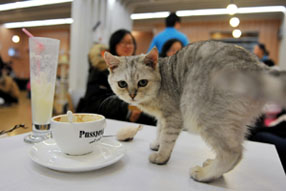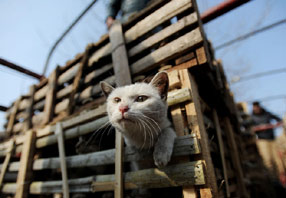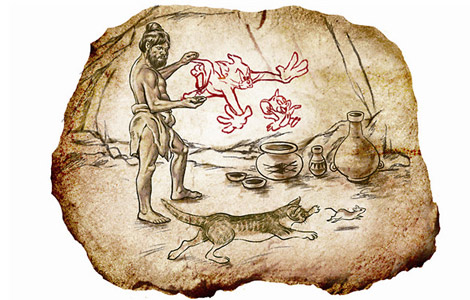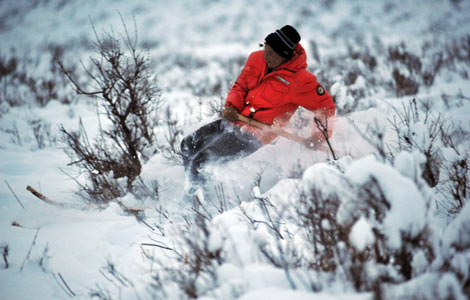Find provides grave paws for thought
Updated: 2014-01-23 09:42
By Zhang Lei (China Daily)
|
|||||||||||

According to Li Jianmin, a professor at the College of Wildlife Resources, Northeast Forestry University, cats are not ideal candidates for domestication, but mutual interests resulted in felines and humans bonding together.
"Most of the animals that became domesticated were gregarious groups with significant class distinctions. Our ancestors took advantage of those distinctions, replacing the 'leaders' and thus establishing more cohesive and effective control over the animals. As long as there was sufficient food, animals such as pigs, cows and sheep adapted easily to small, enclosed spaces," he said.
"Instead, the cat is a solitary hunter. In order to defend their own territory, they act ruthlessly to their peers. In addition, most domesticated animals mainly eat plants; even dogs evolved from predators to omnivores and can eat practically anything. Cats, however, are 'obligate carnivores', which means they can't digest anything other than meat," he added.
Cats cannot digest carbohydrates and are unable to taste sweet food. Moreover, even domesticated cats are often disobedient. These characteristics suggest that the ancestors of modern domestic cats were willing to live with people simply because they saw opportunities in human communities.
Hu Yaowu referred to this pattern of behavior as "self-domestication". Rather than humans taking the lead, some scientists contend that cats "domesticated humans", who were deceived into believing the opposite.
Hu said the findings in Quanhucun may challenge the established belief that the earliest communication between East and West occurred via the Silk Road 2,000 years ago. The Yangshao Culture (7000-5000 BC) was the first Neolithic Chinese culture within the territory of the Yellow River valley, and the Quanhucun site belongs to the Middle to Late Yangshao Culture (6000-5000 BC).
The Fertile Crescent
 |
|
|
 |
|
2,800 stray cats on the way to be slaughtered saved
|
If the cats in the region weren't domesticated by the Chinese, it's highly possible that they were introduced from the Fertile Crescent - a relatively moist and fertile zone in Western Asia, the Nile valley and its delta. Studies of the DNA of both modern feral and domestic cats demonstrate that the ancient wildcats of the Fertile Crescent were their maternal ancestors. The semi-arid region also gave birth to the earliest human agricultural civilizations; the cultivation of beans and wheat is known to have originated there, along with the first domesticated sheep, pigs and cows.
"Modern Chinese domestic cats may originate from the Fertile Crescent. If that's the case, we can say that the Chinese started to communicate with the West much earlier than previously thought, so the connection may well go back 5,000 years. This will help us to study the spread of agriculture across the globe," Hu said.
Rats are a great temptation to cats, which made the garbage dumps in ancient villages tremendously appealing. Unlike their cousins, lions, leopards and suchlike, cats living in the ancient settlements didn't need to sharpen their hunting skills.
When the sources of food were relatively stable, the cats adapted to a companionable life alongside humans. Yet they are a solitary species and fierce competition for resources and survival not only challenged their evolution, but also limited their degree of obedience to humans.
Over time, they began to better integrate with the human environment, while remaining adept hunters with the ability to distinguish food from garbage. Even today, most domestic cats can survive easily, even if they are abandoned. "That point is proved by the large numbers of stray cats in the cities. You don't see large numbers of stray dogs, because they are unlikely to survive for long," Hu said.
Cute and clever
During the process of assimilation, cats may have altered some of their features to develop a more intimate relationship with humans. Compared with their feral counterparts, domestic cats have bigger eyes, flatter, rounder faces and higher foreheads, thus presenting a cute and clever appearance that encourages people to feed them.
In 2004, Jean-Denis Vigne, an archeologist with the National Museum of Natural History in Paris, discovered the bones of a wild cat alongside human remains in a 9,500-year-old grave on the island of Cyprus, currently the earliest discovery of a connection between humans and cats.
It may be that feline evolution will begin all over again as cats adapt to changes in human behavior brought about by technology - modern dogs have a completely different appearance to their ancestors, while in general domestic cats still maintain many links with their feral forebears.
Perhaps during the long hours they spend asleep - the main priority for some, or so it seems - cats engage in philosophical contemplation, meditating on the mysteries of the universe and the meaning of life alongside humans.
After all, as Detlef Bluhm, one of Germany's greatest feline experts, wrote in The Big Cat Encyclopaedia, "cats are witnesses of the progress of human civilization".
Contact the writer at zhanglei@chinadaily.com.cn
Related Stories
Cats were friends of Chinese since ancient times 2014-01-17 07:17
2,800 stray cats saved from meat market 2014-01-16 09:28
Research shows Chinese used cats 5,300 years ago 2013-12-24 16:18
Bone find gives cats a historic role 2013-12-19 15:21
Big turnaround or just a dead-cat bounce? 2013-10-28 07:26
Big cats are part of the family 2013-09-26 11:42
Today's Top News
Xi urges leading group to push reforms
Boeing delivers record number of planes to China
Li calls for cooperative global economic system
China to keep up with transgenics
Big rise in Chinese overseas
Police welcome microblog tip-offs
China OKs 12 more free trade zones
Man, 36, executed for rape, murder of sex slaves
Hot Topics
Lunar probe , China growth forecasts, Emission rules get tougher, China seen through 'colored lens', International board,
Editor's Picks

|

|

|

|

|

|





